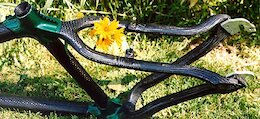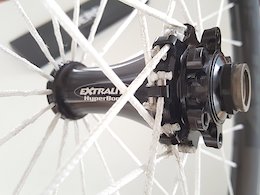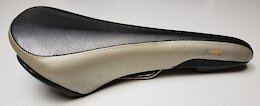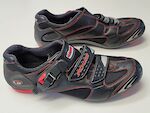Pinkbike.com
Powered by Outside
R-M-R
- Member since Dec 15, 2009
-
 Calgary , Alberta
Calgary , Alberta - 127 Followers
- 13 Trailforks Points
Recent

R-M-R jessiemaymorgan's article
Jul 8, 2024 at 2:55
Jul 8, 2024
Motion Engineering Are Developing a Sub-1200 Gram Single-Sided XC Linkage Fork - Eurobike 2024
@RadBartTaylor:
1. Axle path shaped like the letter J. The path was initially so rearward that vertical impacts, such as a "slap-down" impact, had an extremely low compliance ratio, leading to the harshness frequently reported from such impacts.
2. Extremely digressive motion ratio curve. This isn't necessarily a bad thing if a spring curve and damping curve can be created that combine with the motion ratio to result in the desired wheel rate. For example, a digressive motion ratio curve and a progressive spring rate curve could combine to be a perfectly flat wheel rate. This was not the case for the Trust products, despite their best efforts with an unconventional damper and spring.
These properties combined to create products that were moderately to very harsh early in the stroke and had poor support deep in the travel.
As I've said many times, I believe in the potential of front linkage suspension, but the execution of the Trust products was not optimal.

R-M-R TEBP's article
Jul 6, 2024 at 8:05
Jul 6, 2024
Eurobike 2024: Exciting Products from European Manufacturers - Part 2
@vinay: Their prices were toward the high end of the spectrum, with below-average stiffness to weight ratios for the rear stays.

R-M-R TEBP's article
Jul 5, 2024 at 19:34
Jul 5, 2024
Eurobike 2024: Exciting Products from European Manufacturers - Part 2
@vinay: I'll be impressed when someone makes a machined frame at a viable price with hollow chainstays and seatstays - or, to be more outcome-focused than process-focused, create the same stiffness to weight ratio as other frames at comparable prices.

R-M-R jessiemaymorgan's article
Jul 4, 2024 at 18:21
Jul 4, 2024
Motion Engineering Are Developing a Sub-1200 Gram Single-Sided XC Linkage Fork - Eurobike 2024
@rivercitycycles: Even if we ignore the price, trust forks had flawed kinematics. They failed on merit, or lack thereof. Doesn't mean the concept is a non-starter, just that it's difficult to get right, with almost zero prior art to draw upon, and typically more expensive to produce. That's a lot to overcome for any company considering creating such a product - not to mention the negative perception created by most prior front linkage products.

R-M-R jessiemaymorgan's article
Jul 4, 2024 at 18:11
Jul 4, 2024
Motion Engineering Are Developing a Sub-1200 Gram Single-Sided XC Linkage Fork - Eurobike 2024
@justinfoil,
Indeed. It's like saying "all [rear suspension type] [behaviour] [situation]".
@haen,
For example, "all single-pivot swingarm frames have considerable brake anti-rise". Not if the pivot is super low. Not (necessarily) if a floating brake linkage is used. It's just a design choice to put the pivot in the usual location because most people feel that's the best compromise.
"All Horst-link bikes pedal less firmly than dw-link bikes." That's just due to the design choices of many Horst-link designers (notably, most old-school models and Specialized until a few years ago) vs. Dave Weagle and his clients. Could be the inverse if the designers wanted it to be.
Similarly, the properties of front linkages are what their designers have chosen. Many designers have chosen very high anti-dive, but that's not an intrinsic property of any particular front linkage configuration. Some configurations would make it difficult to avoid that outcome without a floating brake linkage, but it still isn't an intrinsic property. A single-pivot, leading-link front linkage with a more-or-less horizontal link will have a high anti-dive value (possibly rising when braking, as mentioned) without a floating brake linkage. Multi-link designs or single-pivots with a floating link offer tremendous design flexibility in their kinematics.

R-M-R CassLabs's article
Jul 1, 2024 at 13:41
Jul 1, 2024
How do Tire Inserts Affect the Ride?
Interesting test and results. The similarity between high-pressure run (with and without CushCore) vs. the low-pressure run suggests the missing piece is to test a low-pressure, no insert configuration. Maybe Nicky is simply running excessive pressure, maybe his standard pressure is necessary and inserts are the only way to run a lower pressure without whatever negative effects led him to the higher standard pressure, or maybe the standard pressure was was arrived at as a way to prevent extreme outlier events that could be tolerated to gain the benefits of a lower pressure.
Further testing could be whether it's a better solution to use a more robust casing without an insert or a lighter casing with an insert.

R-M-R OneUpComponents's article
Jun 25, 2024 at 16:20
Jun 25, 2024
OneUp Announces New Hubs
Interesting choice to leave [L=https://www.newmen-components.de/Naben]Newmen[/L] off the list.

R-M-R Mandownmedia's article
Jun 21, 2024 at 23:22
Jun 21, 2024
Bike Check: Martin Maes' Orbea Rallon
@wslee: The bottle could wear through the shock body eventually, but it's going to take a while and can be monitored.
It seems possible to avoid the situation with a spacer under the rearward bottle mount to tilt the bottle downward, or source a cage that positions the bottle rearward, such as the Elite Ciussi Side Access with the plastic lower stop removed.

R-M-R dariodigiulio's article
Jun 21, 2024 at 16:18
Jun 21, 2024
Pinkbike Poll: Are XC Courses Getting Too Gnarly?
@onemanarmy: The best answer is to write to the UCI, race sponsors, and team sponsors. The real answer is that we just keep complaining about it on Pinkbike. It's a win either way!
29,479 views
224 Photos
5 Blog Posts
- Faux-bar or four-bar? Jun 13, 2023 – Comments: 12
- Damping Curves - Digressive, Linear, Progressive Feb 15, 2021 – Comments: 4
- Slideway lubricant as bath oil Feb 2, 2021 – Comments: 9
- How much does mass matter - Hubs Feb 1, 2021 – Comments: 7
- Insight into chainless WC DH runs Jan 13, 2021 – Comments: 10






